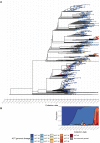Public health interventions successfully mitigated multiple incursions of SARS-CoV-2 Delta variant in the Australian Capital Territory
- PMID: 36786292
- PMCID: PMC10024954
- DOI: 10.1017/S0950268823000201
Public health interventions successfully mitigated multiple incursions of SARS-CoV-2 Delta variant in the Australian Capital Territory
Abstract
The COVID-19 pandemic has presented a unique opportunity to understand how real-time pathogen genomics can be used for large-scale outbreak investigations. On 12 August 2021, the Australian Capital Territory (ACT) detected an incursion of the SARS-CoV-2 Delta (B.1.617.2) variant. Prior to this date, SARS-CoV-2 had been eliminated locally since 7 July 2020. Several public health interventions were rapidly implemented in response to the incursion, including a territory-wide lockdown and comprehensive contact tracing. The ACT has not previously used pathogen genomics at a population level in an outbreak response; therefore, this incursion also presented an opportunity to investigate the utility of genomic sequencing to support contact tracing efforts in the ACT. Sequencing of >75% of the 1793 laboratory-confirmed cases during the 3 months following the initial notification identified at least 13 independent incursions with onwards spread in the community. Stratification of cases by genomic cluster revealed that distinct cohorts were affected by the different incursions. Two incursions resulted in most of the community transmission during the study period, with persistent transmission in vulnerable sections of the community. Ultimately, both major incursions were successfully mitigated through public health interventions, including COVID-19 vaccines. The high rates of SARS-CoV-2 sequencing in the ACT and the relatively small population size facilitated detailed investigations of the patterns of virus transmission, revealing insights beyond those gathered from traditional contact tracing alone. Genomic sequencing was critical to disentangling complex transmission chains to target interventions appropriately.
Keywords: Australian Capital Territory; COVID-19; SARS-CoV-2; genomic epidemiology; pandemic.
Conflict of interest statement
None.
Figures




References
-
- Covid-19 National Incident Room Surveillance Team (2020) COVID-19 Australia: epidemiology report 10 (reporting week to 23:59 AEST 5 April 2020). Communicable Diseases Intelligence 44. - PubMed
-
- Covid-19 National Incident Room Surveillance Team (2020) COVID-19 Australia: epidemiology report 18 (fortnightly reporting period ending 7 June 2020). Communicable Diseases Intelligence 44. - PubMed
-
- Covid-19 National Incident Room Surveillance Team (2020) COVID-19 Australia: epidemiology report 27 (fortnightly reporting period ending 11 October 2020). Communicable Diseases Intelligence 44. - PubMed
-
- Covid-19 National Incident Room Surveillance Team (2021) COVID-19 Australia: epidemiology report 32 (four-week reporting period ending 3 January 2021). Communicable Diseases Intelligence 45. - PubMed
-
- Covid-19 National Incident Room Surveillance Team (2021) COVID-19 Australia: epidemiology report 47 (reporting period ending 1 August 2021). Communicable Diseases Intelligence 45. - PubMed
Publication types
MeSH terms
Substances
Supplementary concepts
LinkOut - more resources
Full Text Sources
Medical
Miscellaneous

